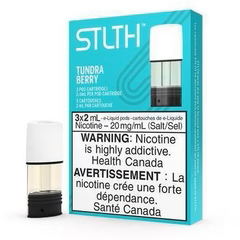Keeping up with the latest trends in teen culture can be a challenge for parents. One trend that's becoming increasingly concerning is the use of vape products, specifically Stlth Vape Pods. Whether you're a parent, a health-conscious consumer, or a vape enthusiast, understanding these devices is crucial. This guide will shed light on what Stlth Vape Pods are, their impact on health, and how you can approach this topic with your children.
The Rise of Vaping in Canada
Vaping has surged in popularity over the last few years, especially among Canadian teens. According to recent statistics, nearly one in five high school students in Canada have tried vaping. This rise is attributed to the perception that vaping is a safer alternative to smoking and the variety of flavors available.
However, the dangers of nicotine addiction and the potential health risks associated with vaping cannot be ignored. Parents need to be aware of these trends and the products their children might be using.
What Are Stlth Vape Pods?
Stlth Vape Pods are a type of e-cigarette designed for convenience and discretion. Unlike larger vape devices, Stlth Pods are compact and easy to carry, making them particularly appealing to teens. They come pre-filled with e-liquid, which means users don't have to deal with the mess of refilling tanks.
The pods are available in various flavors, from traditional tobacco to fruity and sweet options. Each pod contains nicotine, which can be highly addictive, especially for young users.
How Do Stlth Vape Pods Work?
Understanding how Stlth Pro Pods work can help parents recognize them and discuss their use with their children. These devices consist of a battery, a heating element, and a pod containing e-liquid. When the user inhales, the battery activates the heating element, which vaporizes the e-liquid, producing a mist that is inhaled.
The simplicity of these devices makes them accessible to teens, but it also means that they can easily overuse them, leading to higher nicotine consumption.
The Health Risks Associated with Vaping
While vaping is often marketed as a safer alternative to smoking, it is not without risks. Research has shown that vaping can lead to respiratory issues, cardiovascular problems, and nicotine addiction. For young users, the impact can be even more severe, affecting brain development and leading to long-term addiction.
Parents should be aware of these risks and communicate them to their children. It's essential to dispel the myth that vaping is harmless and to provide accurate information about its potential dangers.
Identifying Stlth Vape Pods
Recognizing Stlth Vape Pods can be challenging, especially since they are designed to be discreet. However, there are some telltale signs that parents can look out for. These include small, USB-like devices, unfamiliar scents (often fruity or sweet), and discarded pods or packaging.
Being able to identify these devices can help parents address the issue more effectively and have informed conversations with their children about vaping.
Talking to Your Children About Vaping
Approaching the topic of vaping with your children can be daunting, but open communication is key. Start by educating yourself about the different aspects of vaping and the specific risks associated with it. Then, have an honest conversation with your child, expressing your concerns and listening to their perspective.
Ensure that your child feels supported and understood, and provide them with the information they need to make informed choices. Encourage them to ask questions and seek out more information if they're curious.
Alternative Activities and Interests
One way to discourage vaping is to encourage alternative activities and interests. Engaging your children in sports, hobbies, and other positive activities can help reduce the temptation to vape. By keeping them busy and involved in activities they enjoy, they are less likely to turn to vaping out of boredom or peer pressure.
Encourage your children to explore new interests, whether it's joining a club, taking up a new sport, or pursuing a creative hobby. Providing them with healthy outlets for their energy and curiosity can make a significant difference.
Community Resources and Support
Many communities offer resources and support for parents and teens dealing with vaping issues. Schools, local health organizations, and community centers can provide educational materials, support groups, and counseling services. Parents should take advantage of these resources to better understand vaping and to find support in addressing the issue with their children.
Connecting with other parents and sharing experiences can also be helpful. By working together, parents can create a supportive network and share strategies for dealing with vaping.
The Role of Schools
Schools play a critical role in addressing the vaping epidemic among teens. Many schools have implemented educational programs to raise awareness about the risks of vaping and to discourage its use. Parents should work closely with schools to ensure that their children are receiving accurate information about vaping.
Attend school meetings, engage with teachers and administrators, and advocate for comprehensive vaping education programs. By collaborating with schools, parents can help create a safer environment for their children.
Government Regulations and Policies
Understanding the regulations and policies surrounding vaping in Canada can help parents stay informed and take action. The Canadian government has implemented various measures to regulate the sale and marketing of vape products, including restrictions on advertising and age limits for purchasing.
Parents should familiarize themselves with these regulations and advocate for stronger policies if necessary. By staying informed and engaged, parents can help influence positive changes in their communities.
Personal Stories and Testimonials
Hearing personal stories and testimonials from individuals who have experienced the effects of vaping can be powerful. Many former vapers share their experiences to raise awareness and prevent others from making the same mistakes.
Parents can use these stories as educational tools to help their children understand the real-life consequences of vaping. Sharing these accounts can make the risks of vaping more relatable and impactful for teens.
Supporting Teens in Quitting Vaping
For teens who are already vaping, quitting can be challenging but not impossible. Parents should offer support and encouragement, helping their children find resources and strategies to quit. This may include counseling services, support groups, and quit-smoking programs.
It's important to approach the topic with empathy and understanding, recognizing that quitting is a process that may take time. Celebrate small successes and provide ongoing support to help your child on their journey to becoming vape-free.
Future Trends in Vaping
The landscape of vaping is constantly evolving, with new products and trends emerging regularly. Parents should stay informed about these changes to better understand the environment their children are navigating.
Keep up with the latest research, news, and developments in the vaping industry. Staying informed will help parents address new challenges and continue to support their children in making healthy choices.
Conclusion
The rise of vaping among teens is a concerning trend that requires proactive involvement from parents, educators, and the community. By understanding the risks associated with Stlth Vape Pods and other vaping products, parents can better support their children in making informed decisions.
Open communication, education, and support are key to addressing this issue. Encourage your children to explore healthy alternatives, stay informed about the latest trends, and seek out community resources to create a supportive environment.
If you're looking for more information and support, consider reaching out to local health organizations and community resources. Together, we can work towards a healthier future for our children.

